Measurement of the $B^0 \to D^{*-} \tau^+ \nu_{\tau}$ branching fraction using three-prong $\tau$ decays
[to restricted-access page]Information
LHCb-PAPER-2017-027
CERN-EP-2017-256
arXiv:1711.02505 [PDF]
(Submitted on 07 Nov 2017)
Phys. Rev. D 97, 072013
Inspire 1634841
Tools
Abstract
The ratio of branching fractions ${\cal{R}}(D^{*-})\equiv {\cal{B}}(B^0 \to D^{*-} \tau^+ \nu_{\tau})/{\cal{B}}(B^0 \to D^{*-} \mu^+\nu_{\mu})$ is measured using a data sample of proton-proton collisions collected with the LHCb detector at center-of-mass energies of 7 and 8 TeV, corresponding to an integrated luminosity of 3$ $fb$^{-1}$. The $\tau$ lepton is reconstructed with three charged pions in the final state. A novel method is used that exploits the different vertex topologies of signal and backgrounds to isolate samples of semitauonic decays of $b$ hadrons with high purity. Using the $B^0 \to D^{*-}\pi^+\pi^-\pi^+$ decay as the normalization channel, the ratio ${\cal{B}}(B^0 \to D^{*-} \tau^+ \nu_{\tau})/{\cal{B}}(B^0 \to D^{*-}\pi^+\pi^-\pi^+)$ is measured to be $1.97 \pm 0.13 \pm 0.18$, where the first uncertainty is statistical and the second systematic. An average of branching fraction measurements for the normalization channel is used to derive ${\cal{B}}(B^0 \to D^{*-} \tau^+ \nu_{\tau}) = (1.42 \pm 0.094 \pm 0.129 \pm 0.054) \%$, where the third uncertainty is due to the limited knowledge of ${\cal{B}}(B^0\to D^{*-}\pi^+\pi^-\pi^+)$. A test of lepton flavor universality is performed using the well-measured branching fraction ${\cal{B}}(B^0 \to D^{*-} \mu^+\nu_{\mu})$ to compute ${\cal{R}}(D^{*-}) = 0.291 \pm 0.019 \pm 0.026 \pm 0.013$, where the third uncertainty originates from the uncertainties on ${\cal{B}}(B^0 \to D^{*-}\pi^+\pi^-\pi^+)$ and ${\cal{B}}(B^0 \to D^{*-} \mu^+\nu_{\mu})$. This measurement is in agreement with the Standard Model prediction and with previous measurements.
Figures and captions
|
Topology of the signal decay. A requirement on the distance between the 3 $\pi $ and the $ B ^0$ vertices along the beam direction to be greater than four times its uncertainty is applied. |
Fig1.pdf [228 KiB] HiDef png [366 KiB] Thumbnail [151 KiB] *.C file |

|
|
Distribution of the distance between the $ B ^0$ vertex and the 3 $\pi $ vertex along the beam direction, divided by its uncertainty, obtained using simulation. The vertical line shows the 4$\sigma$ requirement used in the analysis to reject the prompt background component. |
Fig2.pdf [21 KiB] HiDef png [201 KiB] Thumbnail [173 KiB] *.C file |

|
|
Distribution of the $3\pi$ mass for candidates after the detached-vertex requirement. The $ D ^+$ and $ D ^+_ s $ mass peaks are indicated. |
Fig3.pdf [14 KiB] HiDef png [155 KiB] Thumbnail [138 KiB] *.C file |

|
|
Distribution of the $ K ^- 3\pi$ mass for $D^0$ candidates where a charged kaon has been associated to the 3 $\pi $ vertex. |
Fig4.pdf [14 KiB] HiDef png [136 KiB] Thumbnail [133 KiB] *.C file |

|
|
Distribution of the $ D ^{*-} {3\pi}$ mass (blue) before and (red) after a requirement of finding an energy of at least 8 $\mathrm{ Ge V}$ in the electromagnetic calorimeter around the 3 $\pi $ direction. |
Fig5.pdf [16 KiB] HiDef png [183 KiB] Thumbnail [165 KiB] *.C file |

|
|
Distribution of the $ K ^-$ $\pi ^+$ $\pi ^+$ mass for $D^+$ candidates passing the signal selection, where the negative pion has been identified as a kaon and assigned the kaon mass. |
Fig6.pdf [14 KiB] HiDef png [126 KiB] Thumbnail [121 KiB] *.C file |

|
|
Distribution of the $ D ^{*-} 3\pi$ mass for candidates passing the selection. |
Fig7.pdf [14 KiB] HiDef png [152 KiB] Thumbnail [149 KiB] *.C file |

|
|
Difference between the reconstructed and true $ q^2$ variables divided by the true $ q^2$ , observed in the $ B ^0 \rightarrow D ^{*-} \tau ^+ \nu _\tau $ simulated signal sample after partial reconstruction. |
Fig8.pdf [14 KiB] HiDef png [122 KiB] Thumbnail [124 KiB] *.C file |

|
|
Distribution of the reconstructed $3\pi N$ mass observed in a data sample enriched by $ B \rightarrow D ^{*-} D ^+_ s (X)$ candidates. |
Fig9.pdf [16 KiB] HiDef png [106 KiB] Thumbnail [60 KiB] *.C file |

|
|
Normalized distributions of (a) $\min[m(\pi^+ \pi^-)]$, (b) $\max[m(\pi^+\pi^-)]$, (c) approximated neutrino momentum reconstructed in the signal hypothesis, and (d) the $D^{*-} 3\pi$ mass in simulated samples. |
Fig10a.pdf [16 KiB] HiDef png [168 KiB] Thumbnail [145 KiB] *.C file |

|
|
Fig10b.pdf [15 KiB] HiDef png [190 KiB] Thumbnail [177 KiB] *.C file |

|
|
|
Fig10c.pdf [16 KiB] HiDef png [183 KiB] Thumbnail [152 KiB] *.C file |
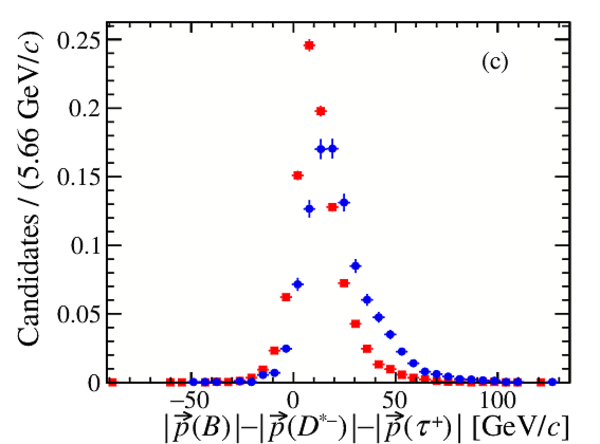
|
|
|
Fig10d.pdf [17 KiB] HiDef png [237 KiB] Thumbnail [203 KiB] *.C file |
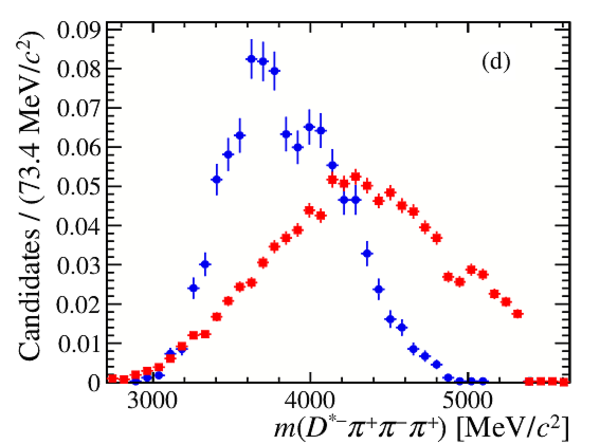
|
|
|
Distribution of the BDT response on the signal and background simulated samples. |
Fig11.pdf [16 KiB] HiDef png [174 KiB] Thumbnail [145 KiB] *.C file |

|
|
Composition of an inclusive simulated sample where a $ D ^{*-}$ and a 3 $\pi $ system have been produced in the decay chain of a $ b $ $\overline b $ pair from a $pp$ collision. Each bin shows the fractional contribution of the different possible parents of the 3 $\pi $ system (blue from a $ B ^0$ , yellow for other $ b $ hadrons): from signal; directly from the $ b $ hadron (prompt); from a charm parent $ D ^+_ s $ , $ D ^0$ , or $ D ^+$ meson; 3 $\pi $ from a $ B$ and the $ D ^0$ from the other $ B$ ($B1B2$); from $\tau$ lepton following a $ D ^+_ s $ decay; from a $\tau$ lepton following a $D^{**}\tau ^+ \nu _\tau $ decay ($D^{**}$ denotes here any higher excitation of $ D$ mesons). (Top) After the initial selection and the removal of spurious $3\pi$ candidates. (Middle) For candidates entering the signal fit. (Bottom) For candidates populating the last 3 bins of the BDT distribution (cf. Fig. 16). |
Fig12.pdf [17 KiB] HiDef png [138 KiB] Thumbnail [134 KiB] *.C file |

|
|
Distributions of (a) ${\mathrm{min}}[m(\pi^+\pi^-)]$, (b) ${\mathrm{max}}[m(\pi^+\pi^-)]$, (c) $m(\pi^+\pi^+)$, (d) $m(\pi^+\pi^-\pi^+)$ for a sample enriched in $ B \rightarrow D ^{*-} D ^+_ s (X)$ decays, obtained by requiring the BDT output below a certain threshold. The different fit components correspond to $ D ^+_ s $ decays with (red) $\eta$ or (green) $\eta ^{\prime} $ in the final state, (yellow) all the other considered $ D ^+_ s $ decays, and (blue) backgrounds originating from decays not involving the $ D ^+_ s $ meson. |
Fig13.pdf [31 KiB] HiDef png [408 KiB] Thumbnail [306 KiB] *.C file |

|
|
Results from the fit to data for candidates containing a $ D ^{*-}$ $ D ^+_ s $ pair, where $ D ^+_ s \rightarrow 3\pi$. The fit components are described in the legend. The figures correspond to the fit projection on (a) $m(D^{*-}3\pi)$, (b) $q^2$, (c) 3 $\pi $ decay time $t_{\tau}$ and (d) BDT output distributions. |
Fig14a.pdf [31 KiB] HiDef png [240 KiB] Thumbnail [228 KiB] *.C file |
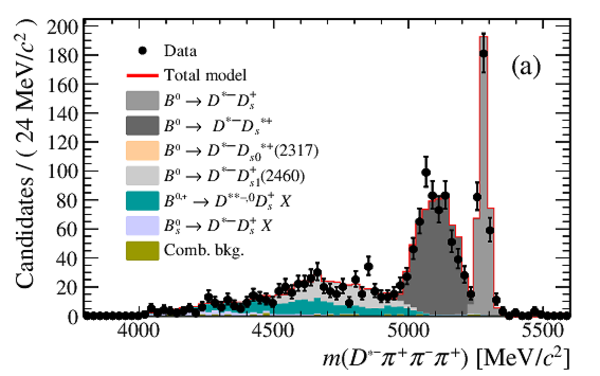
|
|
Fig14b.pdf [30 KiB] HiDef png [189 KiB] Thumbnail [171 KiB] *.C file |

|
|
|
Fig14c.pdf [18 KiB] HiDef png [154 KiB] Thumbnail [160 KiB] *.C file |

|
|
|
Fig14d.pdf [19 KiB] HiDef png [156 KiB] Thumbnail [153 KiB] *.C file |

|
|
|
Distribution of $q^2$ for candidates in the $B\rightarrow D^{*-}D^0(X)$ control sample, after correcting for the disagreement between data and simulation. |
Fig15.pdf [17 KiB] HiDef png [194 KiB] Thumbnail [179 KiB] *.C file |

|
|
Projections of the three-dimensional fit on the (a) $3\pi$ decay time, (b) $q^2$ and (c) BDT output distributions. The fit components are described in the legend. |
Fig16a.pdf [16 KiB] HiDef png [153 KiB] Thumbnail [148 KiB] *.C file |

|
|
Fig16b.pdf [14 KiB] HiDef png [97 KiB] Thumbnail [92 KiB] *.C file |

|
|
|
Fig16c.pdf [14 KiB] HiDef png [91 KiB] Thumbnail [87 KiB] *.C file |

|
|
|
Distributions of (a) $t_{\tau}$ and (b) $q^2$ in four different BDT bins, with increasing values of the BDT response from top to bottom. The fit components are described in the legend. |
Fig17.pdf [25 KiB] HiDef png [356 KiB] Thumbnail [310 KiB] *.C file |
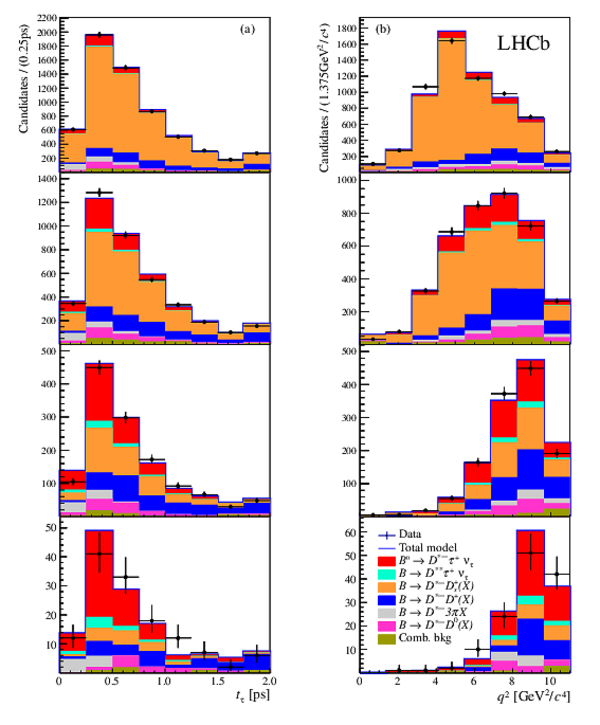
|
|
Projection of the fit results on (a) ${\mathrm{min}}[m(\pi^+\pi^-)]$ and (b) $m(D^{*-}3\pi)$ distributions. The fit components are described in the legend. |
Fig18a.pdf [16 KiB] HiDef png [151 KiB] Thumbnail [144 KiB] *.C file |

|
|
Fig18b.pdf [18 KiB] HiDef png [199 KiB] Thumbnail [187 KiB] *.C file |

|
|
|
Fit to the $m(D^{*-}3\pi)$ distribution after the full selection in the (a) $\sqrt{s}=7$ TeV and (b) $8$ TeV data samples. |
Fig19a.pdf [29 KiB] HiDef png [247 KiB] Thumbnail [218 KiB] *.C file |
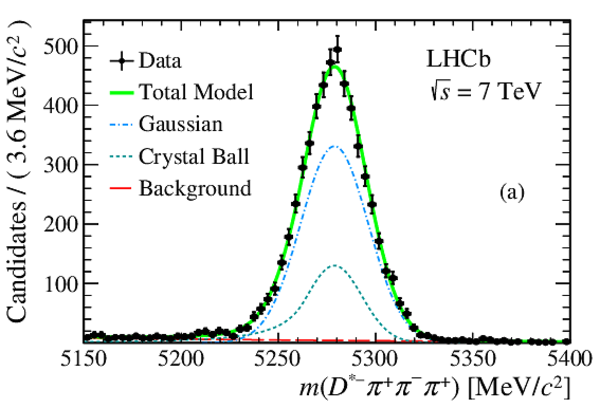
|
|
Fig19b.pdf [30 KiB] HiDef png [254 KiB] Thumbnail [216 KiB] *.C file |

|
|
|
(a) Distribution of $m(3\pi)$ after selection, requiring $m(D^{*-} 3\pi)$ to be between 5200 and 5350 $ {\mathrm{ Me V /}c^2}$ ; (b) fit in the mass region around the $ D ^+_ s $ . |
Fig20a.pdf [18 KiB] HiDef png [163 KiB] Thumbnail [158 KiB] *.C file |

|
|
Fig20b.pdf [19 KiB] HiDef png [212 KiB] Thumbnail [194 KiB] *.C file |
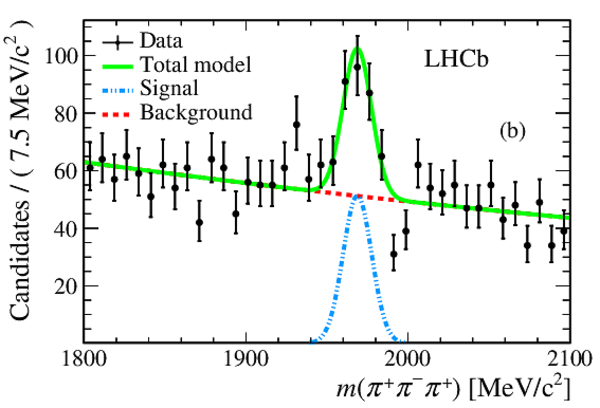
|
|
|
Animated gif made out of all figures. |
PAPER-2017-027.gif Thumbnail |

|
Tables and captions
|
List of the selection cuts. See text for further explanation. |
Table_1.pdf [80 KiB] HiDef png [83 KiB] Thumbnail [38 KiB] tex code |

|
|
Summary of the efficiencies (in %) measured at the various steps of the analysis for simulated samples of the $ B ^0 \rightarrow D ^{*-} 3\pi$ channel and the $ B ^0$ $\rightarrow$ $ D ^{*-}$ $\tau ^+$ $\nu _\tau$ signal channel for both $\tau $ decays to 3 $\pi $ $\overline{\nu } _\tau$ and 3 $\pi $ $\pi ^0$ $\overline{\nu } _\tau$ modes. No requirement on the BDT output is applied for $ D ^{*-} 3\pi$ candidates. The relative efficiency designates the individual efficiency of each requirement. |
Table_2.pdf [61 KiB] HiDef png [79 KiB] Thumbnail [33 KiB] tex code |

|
|
Results of the fit to the $ D ^+_ s $ decay model. The relative contribution of each decay and the correction to be applied to the simulation are reported in the second and third columns, respectively. |
Table_3.pdf [69 KiB] HiDef png [147 KiB] Thumbnail [75 KiB] tex code |

|
|
Relative fractions of the various components obtained from the fit to the $B\rightarrow D^{*-}D_{s}^{+}(X)$ control sample. The values used in the simulation and the ratio of the two are also shown. |
Table_4.pdf [87 KiB] HiDef png [75 KiB] Thumbnail [36 KiB] tex code |

|
|
Summary of fit components and their corresponding normalization parameters. The first three components correspond to parameters related to the signal. |
Table_5.pdf [94 KiB] HiDef png [158 KiB] Thumbnail [75 KiB] tex code |

|
|
Fit results for the three-dimensional fit. The constraints on the parameters $f_{D_s^+}$, $f_{D_{s0}^{*+}}$, $f_{D_{s1}^+}$, $f_{D_s^+X}$ and $f_{(D_s^{+}X)_s}$ are applied taking into account their correlations. |
Table_6.pdf [91 KiB] HiDef png [166 KiB] Thumbnail [78 KiB] tex code |

|
|
List of the individual systematic uncertainties for the measurement of the ratio $\mathcal{B} ( B ^0 \rightarrow D^{*-}\tau^+\nu_{\tau})/\mathcal{B} ( B ^0 \rightarrow D^{*-}3\pi)$. |
Table_7.pdf [73 KiB] HiDef png [178 KiB] Thumbnail [80 KiB] tex code |

|
Created on 27 April 2024.
